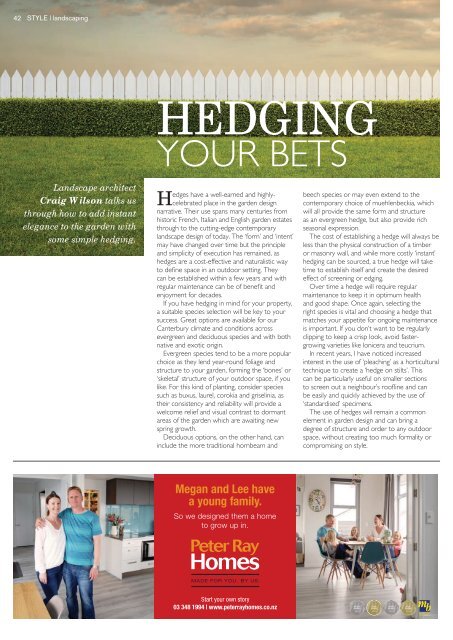Style: August 03, 2017
Create successful ePaper yourself
Turn your PDF publications into a flip-book with our unique Google optimized e-Paper software.
42 STYLE | landscaping<br />
HEDGING<br />
YOUR BETS<br />
Landscape architect<br />
Craig Wilson talks us<br />
through how to add instant<br />
elegance to the garden with<br />
some simple hedging.<br />
Hedges have a well-earned and highlycelebrated<br />
place in the garden design<br />
narrative. Their use spans many centuries from<br />
historic French, Italian and English garden estates<br />
through to the cutting-edge contemporary<br />
landscape design of today. The ‘form’ and ‘intent’<br />
may have changed over time but the principle<br />
and simplicity of execution has remained, as<br />
hedges are a cost-effective and naturalistic way<br />
to define space in an outdoor setting. They<br />
can be established within a few years and with<br />
regular maintenance can be of benefit and<br />
enjoyment for decades.<br />
If you have hedging in mind for your property,<br />
a suitable species selection will be key to your<br />
success. Great options are available for our<br />
Canterbury climate and conditions across<br />
evergreen and deciduous species and with both<br />
native and exotic origin.<br />
Evergreen species tend to be a more popular<br />
choice as they lend year-round foliage and<br />
structure to your garden, forming the ‘bones’ or<br />
‘skeletal’ structure of your outdoor space, if you<br />
like. For this kind of planting, consider species<br />
such as buxus, laurel, corokia and griselinia, as<br />
their consistency and reliability will provide a<br />
welcome relief and visual contrast to dormant<br />
areas of the garden which are awaiting new<br />
spring growth.<br />
Deciduous options, on the other hand, can<br />
include the more traditional hornbeam and<br />
beech species or may even extend to the<br />
contemporary choice of muehlenbeckia, which<br />
will all provide the same form and structure<br />
as an evergreen hedge, but also provide rich<br />
seasonal expression.<br />
The cost of establishing a hedge will always be<br />
less than the physical construction of a timber<br />
or masonry wall, and while more costly ‘instant’<br />
hedging can be sourced, a true hedge will take<br />
time to establish itself and create the desired<br />
effect of screening or edging.<br />
Over time a hedge will require regular<br />
maintenance to keep it in optimum health<br />
and good shape. Once again, selecting the<br />
right species is vital and choosing a hedge that<br />
matches your appetite for ongoing maintenance<br />
is important. If you don’t want to be regularly<br />
clipping to keep a crisp look, avoid fastergrowing<br />
varieties like lonicera and teucrium.<br />
In recent years, I have noticed increased<br />
interest in the use of ‘pleaching’ as a horticultural<br />
technique to create a ‘hedge on stilts’. This<br />
can be particularly useful on smaller sections<br />
to screen out a neighbour’s roofline and can<br />
be easily and quickly achieved by the use of<br />
‘standardised’ specimens.<br />
The use of hedges will remain a common<br />
element in garden design and can bring a<br />
degree of structure and order to any outdoor<br />
space, without creating too much formality or<br />
compromising on style.<br />
Megan and Lee have<br />
a young family.<br />
So we designed them a home<br />
to grow up in.<br />
Start your own story<br />
<strong>03</strong> 348 1994 | www.peterrayhomes.co.nz


















